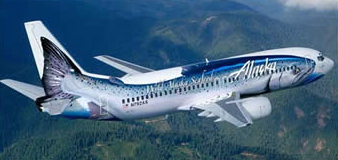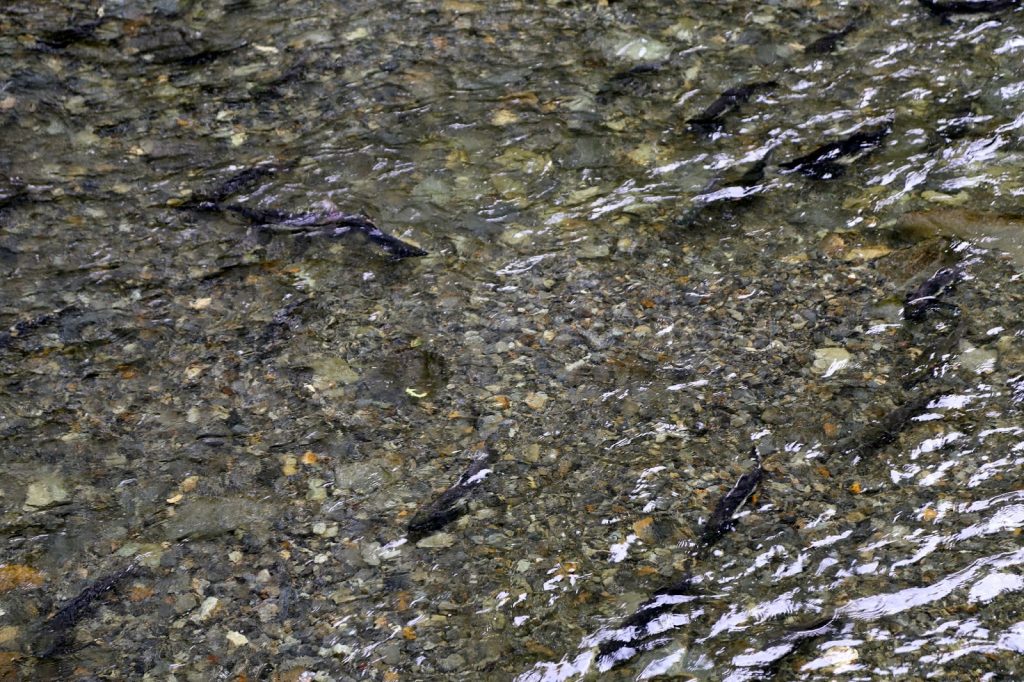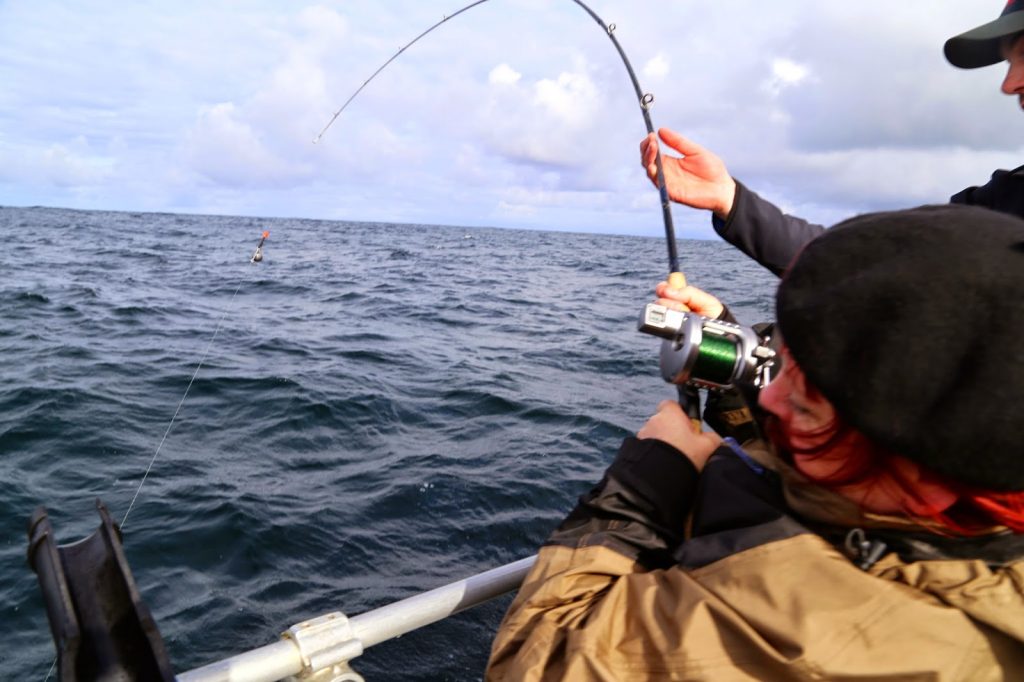 As we sped out towards the ocean, passing a blowing whale, bobbing puffins on the water and Caramac brown sea lions on rocks, it was explained that the type of fish you get depends on the depth of your line and the time of year. There are five types of Pacific salmon, which you can remember via a cerebellum memory game you do on the five fingers of your hand:
As we sped out towards the ocean, passing a blowing whale, bobbing puffins on the water and Caramac brown sea lions on rocks, it was explained that the type of fish you get depends on the depth of your line and the time of year. There are five types of Pacific salmon, which you can remember via a cerebellum memory game you do on the five fingers of your hand:- The little finger, the ‘pinkie’ for Pink salmon, not just a colour but the name.
- The ring finger for ‘silver’ (or Coho) salmon.
- The middle finger, the biggest for ‘king’ salmon.
- The index finger, which can poke your eye out, for ‘sockeye’ salmon.
- Lastly, the thumb represent ‘chum’ salmon, now called Keta.
- Pink: the surface to 50 feet down.
- Silvers: 50 feet to 100 feet.
- Kings: 100 feet plus.
At each stage we were asked, “Are you comfortable?”, “Do you want to go further out to sea?”.
“Yeah, of course”, I breezily replied. I had a passing queasiness but nothing serious.
Once out in the ocean, Matt Damon set me up with some bait, a small sprat, and showed me how to cast and reel in the line. I cast the line, essentially trying to throw a thin bit of string as far away as possible in the water. I managed about a metre away from the boat. Despite my clumsiness, something seemed to occur immediately, the end of the rod bowed. I reeled in, felt the tension, reeled a bit more and kept going, my arm aching with the weight of the fish. Eventually I lifted my rod, directing the end towards the side of the boat. The Mexican ‘Primo’ grabbed a hook attached to a short wooden stick, hooked the half metre sockeye salmon and slung it on the deck. Fishing for 30 seconds and I’d caught something!
“Have some potato chips, the salt will help you”, said Primo. “And how about some ginger ale?”
- The King salmon are the first in the season (May, June), they like big runs.
- Silver salmon are last in the season, they run, go back and forth and jump.
- Pinks like to spin.
- Sockeyes are jumpers.
- Chum are hard fliers, they take some drag.
- King (Chinook) is the largest, with a purple hue, it often has spots on tail. Its mouth is dark.
- Silver has a lighter mouth, no spots on tail, a smaller eye.
- Chum has a pronounced jaw. You can pick it up by the tail easily. It has a sharper dorsal fin, which is more set back. Big pupils.
- Pink salmon has small scales and broad spots on the tail.
- Their colours change depending on what they eat.
 |
The difference between Atlantic and Pacific fishing:
Fish conservation is in the Alaskan constitution of 1959 (Article 8 section 4). As a state, they are unique in having control and monitoring fish stocks and have pioneered fish management, influencing other states. Fishing is a tradition, a way of life, both for Native Alaskans and Modern Alaskans. Everybody in Alaska is touched by fish and the fishing industry.
If biomass means all the fish in the sea, there is an acceptable biological catch (ABC) and total allowable catch (TAC). Alaska allows fisherman to fish at TAC level.
In Britain we have control of 200 miles around our coast but this is open to every member of the EU. This was the price of joining the European Community.
A few Alaskan fish facts:
- ASMI is a public and private organisation.
- Alaska is the 6th largest seafood producer in the world (next in the USA is Louisiana, primarily catfish and shrimp).
- They have a plane that looks like a fish on Alaska airways. the ‘salmon thirty salmon’.
- 53% of the Alaskan catch is pollock, which is low value and doesn’t cost much. The mysterious white fish you might have seen in filet o’ fish, fish fingers, surimi is likely to be Pollock. Pollock grows fast.
- Sockeye salmon and King salmon is the most expensive protein in the world.
- They also supply canned salmon, which is popular in the UK.
- Half the seafood is caught in the winter.
- Salmon and halibut, however, are caught in the summer.
In Alaska, there are three types of fishing: seining, gill nets and trolling. The most artisanal way is ‘trolling’, not to be confused with ‘trawling’. We met a fisherman who uses this technique; it’s a bit like bulk rod fishing, several lines are dragged behind the boat with hooks placed every so often along the line. With this bespoke technique they catch fewer fish, only 60 to 80 salmon a day. The crew, the captain and two workers, when they catch the fish, hit it on the head then cut the gill plate. This is to slow down the lactic acid and prevent the salmon from becoming damaged while it struggles. (In general ASMI are encouraging fishermen to handle their catch carefully, not to bash around the bodies. I saw this also during my visit to Billingsgate where the veteran fishmonger Bill Condon takes care not to move the body of the salmon around too much when slicing). A medical catheter is dropped into the kidney to drain the blood; this can be done in 45 seconds. The crew splay the tail of the fish and place it into the super freezer on the boat, where the salmon is frozen at a temperature of -1ºC/30ºF. The fish doesn’t even go through rigor mortis, in fact it can go through rigor a year later when it thaws. It takes four to twelve hours to freeze the salmon and every so often they dip the fish and glaze it with water to prevent dehydration. Open water fish don’t get any fresher than this.
How long can you keep fresh fish?
After 5 or 6 days a salmon breaks down. At 12 days, it’s mush. I remember going into Tesco at Christmas where they had whole salmon going at a cheap rate. The salmon weren’t even in the fridge, they were on the floor stacked in boxes, Tesco had them for over a week already.
However some fish, particularly white fish, are better when matured, has some flavour. I ate some at an award-winning fish and chip shop in the Shetlands where, because of the freshness, the fish lacked flavour.
 Our catch with packets of salmon roe removed from the females
Our catch with packets of salmon roe removed from the females
When I left Sitka on Alaskan airways from the tiny airport (where The Nugget restaurant serves excellent home-baked fruit pies), I noticed that most of the check-in luggage on trolleys and also on the carousel consisted of large white cardboard boxes labelled ‘chilled’. One of the burly men who formed the majority of the aircraft passenger list said it was fish from their fishing trip. The atmosphere on the flight brimmed with the air of happy testosterone, bottles of whisky ordered from the attendants and passed around. But I didn’t get to fly the ‘salmon thirty salmon’.




















What a fascinating read, and I'd imagine even more so actually doing it! I love learning more about our food, thanks for sharing.
Rosie x
Thanks Rosie so glad you enjoyed the post. x
I imagine that was one hell of an experience to have. I love fishing when I get the chance. My dad has his own small lake just outside of leicester in husbands bosworth. All sorts of species from barbel, carp and even gold fish! I have yet to convince him to let me have a couple of perch to eat though.
I lived in bournemouth for most of my chuldhood and early twenties and I loved going mackerel fishing off bournemouth pier late at night. It was so easy that I didn't even need bait, just a hook with some tin foil on to attract them. I also remmeber on one particular trip, Jim davidson came along to ask me how I was doing, and in a rather grumpy way I told him 'Not very well!' He swiftly left looking a bit miffed.
Alaska is such an amazing place, I'm a bit jealous it has to be said.
Hi Adam, thanks for your comment. Alaska has always been on my bucket list and I was very fortunate to go fishing, trips like that are quite expensive. As I say I've been fishing before but had no luck and to be frank I can't claim any skill this time, it was just pretty easy! Great for the ego!
thank you for this wonderful post. Fantastic photographs, gorgeous colours, what a fabulous experience! Really interesting, thanks
HI Julie, thanks so much for your comment, glad that you enjoyed it!
I wasn't sure roe was really that brightly coloured, I assumed they added dye!
Did you get the hang of recognising the salmon types? They all look the same to me…
Beautiful photo of the lodge at night and an interesting post 🙂
Great post, love the photos and reading about your trip to the big state. Keep it up!
Thank you Aj for your comment
I did recognise them at the time but have forgotten already! Yes the roe is a lurid coral colour. Thanks Caramel x
God, they have such tough lives. And we think the nightclub meat market or Tindr is gruelling…..
Seriously though, good to see you getting your hands dirty with the people who feed America and whose average life span must be considerably lower than mine.
Have you read Heather Lende's memoirs- one of them is called 'If You Lived Here, I'd Know Your Name: News from Small-Town Alaska.' She lives in Haines which is accessible by sea or air and is a small town reporter. Not particularly food based and nor is she 'literary' but her life is real and gives a proper every day insight into the challenges and fun of living in such a remote place. Her follow up book charts the traumatic process of getting her out of town when she was run over by a truck. It is the most arduous, complicated medevac I've read in a while.
Great post Kerstin, as ever.
Well the photographs that you have attached in the post are seems to be very good, and honestly I too love fishing so much so this post is for me. Keep posting and keep growing.
Kenai River Fishing Guides
Wow! The fish looked quite fresh and tasty. Alaska is the most beautiful place for fishing. I enjoyed your article most. Thank you for your nice post.
Alaska is god gifted place. Lots of people get together here for fishing. This is the best place in the world. Nice post and great photography. i like this very much.
Deer, rabbits, squirrel and hogs frequent the woods adjacent the 40 or so acres of water. During their fall and winter migration, it's common to see woodcock digging for earthworms in the soft soil along the waters edge. Look at this site
Above all else an ice angler needs the area of good lakes for ice angling. Normally a lake that produces bunches of fish in the mid year angling season will likewise create various fish in the winter. Visit Here